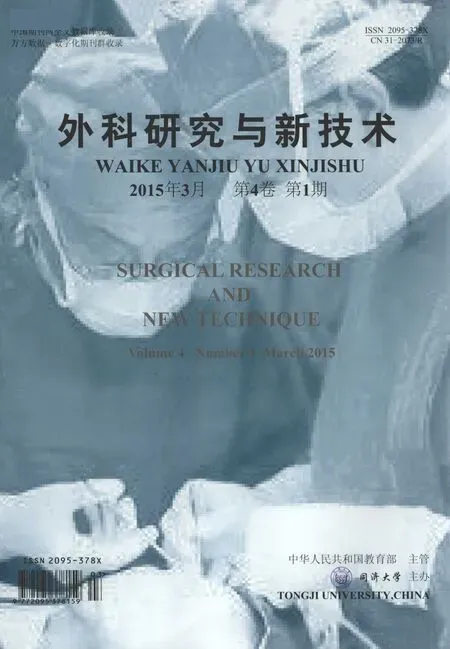胆管内乳头状黏液瘤的诊治进展
周德华(综述),施宝民(审校)同济大学附属同济医院,上海 200065
胆管内乳头状黏液瘤的诊治进展
周德华(综述),施宝民(审校)
同济大学附属同济医院,上海 200065
胆管内乳头状黏液瘤是一种较为罕见的胆管内乳头状肿瘤,近年报道逐渐增多。其主要的表现是由黏液瘤分泌过量的黏液蛋白引起的阻塞性黄疸,CT及磁共振胰胆管造影(MRCP)可见胆道扩张、胆道占位、充盈缺损,胆道镜检查发现大量黏液样胆汁,病理组织活检可证实。该病良性居多,但也有癌变或恶性者。局限性病灶多采用手术进行根治性切除,预后较好。无法耐受手术患者可采取非手术治疗,但效果有限。预后尚需进一步研究。
胆管乳头状黏液性肿瘤;病理分型;诊疗进展
胆管乳头状黏液瘤(intraductal papillary mucinous neoplasm of the bile duct,IPMN-B)相对于胰管内乳头状黏液瘤(Intraductal papillary mucinous neoplasm of the pancreas,IPMN-P)是一种较为罕见的疾病,大部分都是散在病例,大宗报道极少。既往报道,缺乏统一命名,如胆管内乳头状黏液性瘤样变(biliary intraductal papillary)、进行性黏液生成的胆管肿瘤(mucin-producing bile duct tumor)[1]、胆管内高分泌肿瘤(intraductalmucin-hypersecreting tumor)、黏液进行性分泌的胆管癌(mucinproducing cholangiocarcinoma)、黏液高分泌癌(mucinhypersecreting carcinoma)、胆管内黏液性囊状腺样癌(ductectaticmucinous cystadenocarci-noma)、胆管内胆管树黏液样变伴扩张(mucinous ductal ectasia of the biliary tree)和 黏 液 性 赘 生 物(mucinous neoplasm)。IPMN-B最早由Caroli提出,他在1959年报道了1例由乳头状样病变演变为乳头状黏液性恶性腺癌[2],随后在20世纪90年代,具有类似病理特征的肿瘤在肝脏胆管内被发现,因为两种肿瘤都是起源于类似扩张的胆管系统,而且表现出相似的胆管内乳头状生长以及过量的黏液蛋白分泌的特征,因此当时并称为胆管内乳头状黏液样病变(biliary mucinous papillomatosis)[3]。近年,随着对该病认识的加深和影像学技术的发展,发现的病例日渐增多。
·综 述·
1 流行病学
在21世纪初期,IPMN-B的发病被认为主要与华支睾吸虫感染、长期慢性胆管囊肿[4]、胆道阻塞造成的胆道扩张(扩张的形式主要表现为液状、片状或囊状3种形式[5])以及有胆管结石病史有关。也有个别报道认为,其发病是由于基因突变导致的先天性胆管扩张从而演变为胆管内乳头状黏液瘤[3]。
近年报道增多,IPMN-B似乎与胆管结石关系不大。2011年Zen等[6]报道29例中无1例有胆管内结石病史。同年,Yang等[7]的52例报道中主要是中老年患者,其肿瘤恶变程度与年龄呈正相关。最近有报道,胆管内乳头状黏液瘤和胰管内乳头状黏液瘤共发的病例[8-11],提示两者在疾病发生上存在相关性或同源性;也有报道胆管内乳头状黏液瘤和胆管细胞型肝癌在基因表型上的明显相似性[3]。因而推断,IPMN-B、IPMN-P以及胆管细胞型肝癌之间可能存在某种相关性,但具体机制尚待证实。
2 临床表现
胆管内乳头状黏液瘤的早期临床表现没有很强的特异性,最常见的表现主要是由于乳头状黏液瘤的生长以及黏液瘤过量的黏液分泌引起胆管阻塞,从而导致右上腹疼痛(发生率近50%[12])以及较为明显的阻塞性黄疸,其余早期症状偶见眩晕、恶心、呕吐、逐渐消瘦以及食欲下降等,但不具特异性。因此这些早期临床表现对诊断IPMN-B帮助不大,IPMNB的诊断主要依靠影像学检查[13-16]。
3 病理特点及分型
在Jung等(国外93例)、Yang等(国内52例)于2011年总结的病例中,IPMN-B与IPMN-P因形态类似在病理上都分为肠型、胃型、胰腺胆管型和嗜酸细胞瘤型4型;Jung的报道还表明,对黏液瘤分泌的黏液蛋白进行免疫组化分析得到的黏液蛋白核心蛋白表型有对应的病理分型特异性。这4种分型包括:1)肠型:细胞以多层高柱状细胞伴分散高脚杯细胞以及绒毛状乳头突起为特征;其胞质嗜酸性大于嗜碱性,MUC2通常在此表达;2)胃型:细胞以柱状细胞伴丰富的胞浆内黏液为特征,其胞质嗜酸性大于嗜碱性;MUC5A通常在此表达;3)胰腺胆管型:细胞是以立方形短柱状上皮细胞,伴轻微嗜酸性、两嗜性细胞质以及圆形的细胞核为特征,呈细枝样乳头状突起,MUC1在此表达;通常高分泌MUC1肿瘤具有丰富的胞浆内黏液蛋白以及伴周围神经侵袭现象;4)嗜酸细胞瘤型:细胞以丰富的嗜酸性细胞质伴扩大的圆形细胞核为特征,在细胞腔内呈粗枝样的乳头状突起,MUC6通常在此表达[17](注:在囊壁内未发现卵巢样基质)。
国内根据大体标本肉眼观分为如下4型:1)显著的胆管内乳头状肿块>5mm;2)显著的胆管内乳头状肿块,在肿块附近伴颗粒状和微小乳头样破坏;3)仅有颗粒状黏膜<5mm;4)囊状扩张,又根据有无肉眼或镜下可见的黏液蛋白分为2个亚型[3,7,12,17]。
另外,罕见的情况是胆管、胰腺导管同时出现乳头状黏液瘤。当胆胰管同时并发乳头状黏液瘤时,其病理特征主要是因黏液大量分泌和过量聚集而导致的胆胰管(囊状)扩张,并在纤维血管中心有乳头状组织增生[8]。
4 影像学辅助诊断
IPMN-B影像学诊断包括B型超声、CT、磁共振胰胆管造影(MRCP),经内镜逆行性胰胆管造影术(ERCP)以及术中胆道镜检查。由于B型超声中胆胰壶腹区病变易受肠内气体干扰而出现假阴性或假阳性,故上腹部CT平扫为该疾病的首选检查[7,17]。然而,在普通平扫CT上,胆管内乳头状黏液瘤很容易与胆管内结石混淆[18]。因此,对难以确诊的病灶可进一步进行MRCP、增强CT检查。MRCP可清晰地显示囊样扩张的肝内外胆道,若辅以术中胆道镜,可在相应的胆道上区或下区发现堆积的黏液蛋白[13,19]。但临床上仍存在漏诊可能,需进行病理组织活检以确诊[7]。
5 实验室检查指标
对于IPMN-B目前尚缺乏特异的实验室诊断指标。常用的标志物有CEA、CA19-9等。20世纪80年代初认为,CA19-9与其他肝胆内肿瘤一样呈升高趋势,2012年Valente[20]报道CA19-9明显升高的黏液瘤恶性趋势明显;但同年有报道称存在CA19-9正常的患者。CA19-9对胆管内乳头状黏液瘤的诊断价值仍值得进一步探讨。
2014年Fuks[21]在进行两组病例的比较中,单纯性囊肿患者的CEA明显高于乳头状囊肿。因而认为CEA升高可能仅提示单纯性囊肿,对IPMN-B没有诊断价值。总之,CEA、CA19-9、CA50、AFP都可能升高,但与胆管内乳头状黏液瘤没有绝对关联,仅能作为辅助诊断参考。
最近的研究表明,TAG-72具有很高的诊断价值,通常黏液瘤中TAG-72呈高浓度,而单纯性囊肿TAG-72相对表达较低,故具有鉴别诊断意义[21]。
6 治疗策略
6.1手术治疗
根治性手术切除仍是IPMN-B的首选治疗方法,由于该病常是多部位病变同时发生,手术应根治性切除包括病灶所在的胆管本身以及胆管所在的肝段、肝叶[16],并对切除标本进行病理学检查以确定黏液瘤细胞分型。理论上说,肝移植是现在根治该病的唯一方法。有文献报道行肝移植治疗的患者6例[22-28],但随访期限很短,其有效性有待进一步评价。也有报道,对病理学检查证实的胆管乳头状瘤在胆道探查+T管引流术后6~8周行胆道镜下高频电刀烧灼术[29]。
关于手术预后,2006年Zen等[16]报道9例除1例术后30 d死亡外,其余3~156个月随访其内均未出现肿瘤再复发导致的症状,预后良好;2011 年Lim等[13]报道了12例患者,2例肝左叶切除患者存活5年以上;若胆管内黏液性乳头状瘤未侵犯胆管壁深层,预后较好。若胆管内乳头状黏液瘤切除不彻底,有可能诱发肝门周围侵袭性肝内胆管癌[30]。
6.2非手术治疗
非手术治疗并不常用。Valente[20]2012年报道,胆管内乳头状黏液瘤的非手术治疗主要适应证为:①初期无明显症状;②实验室检查CA19-9、CEA、生化检查正常患者;③患者主观拒绝手术或耐受手术能力较差。
可选择的非手术治疗有ERCP、胆道镜对症治疗。ERCP治疗主要用于手术耐受能力差或拒绝手术者,如行ERCP肿瘤刮除,十二指肠乳头切开鼻胆管引流,帮助胆汁引流,缓解症状,恶性者安置支架引流等对症治疗[21]。近期报道,在胆道镜下施行各类新型治疗手段,如肿瘤电凝灼烧治疗+T管内灌注5-FU治疗、激光肿瘤切除术、氩等离子束凝固术、管内iridium-192放疗加电凝疗法[31-32],但因病例数较少,疗效有待进一步确认。对症治疗行经皮经肝胆汁引流,以缓解由胆汁淤积所致的梗阻性黄疸及腹痛[33]。
尽管IPMN-B相对少见,且临床表现缺乏特异性,但结合多种影像学和细胞学检查手段,基本可以明确诊断。经早期诊断和合理治疗,仍能获得相对较好的治疗效果。对其致病因素、发病机制、非手术治疗、与IPMN-P和肝胆管细胞癌的相关性等将有良好的研究前景。
[1] Uchiyama S,Chijiiwa K,Hiyoshi M,et al.Mucin-producing bile duct tumor of the caudate lobe protruding into the commonhepatic duct[J].Gastrointest Surg,2007,11(11):1570-1572.
[2] Caroli J.Papillomas and papillomatoses of the common bile duct[J].Rev M ed ChirM al Foie,1959,34(2):191-230.
[3] Abraham SC,Lee JH,Hruban RH,et al.Molecular and immunohistochem ical analysis of intraductal papillary neoplasms of the biliary tract[J].Hum Pathol,2003,34(9):902-910.
[4] Jang KT,Hong SM,Lee KT,et al.Intraductal papillary neoplasm of the bile duct associated w ith Clonorchis sinensis infection[J].VirchowsArch,2008,453(6):589-598.
[5] Lim JH,Yi CA,LimhK,et al.Radiological spectrum of intraductal papillary tumors of the bile ducts[J].Korean J Radiol,2002,3(1):57-63.
[6] Zen Y,Pedica F,Patcha VR,et al.Mucinous cystic neoplasms of the liver:a clinicopathological study and comparison w ith intraductal papillary neoplasms of the bile duct[J].Mod Pathol,2011,24(8):1079-1089.
[7] Yang JW,Wang,Yan L.The clinicopathological features of intraductal papillary neoplasms of the bile duct in a Chinese population[J].Dig Liver Dis,2012,44(3):251-256.
[8] Xu XW,Li RH,Zhou W,et al.Laparoscopic resection of synchronous intraductal papillary mucinous neoplasms:a case report[J].World JGastroenterol,2012,18(44):6510-6514.
[9] Yamaguchi Y,Abe N,Imase K,et al.A case of mucinhypersecreting intraductal papillary carcinomas occurring simultaneously in liver and pancreas[J].Gastrointest Endosc,2005,61(2):330-334.
[10] Zalinski S,Paradis V,Valla D,et al.Intraductal papillary mucinous tumors of both biliary and pancreatic ducts[J].Jhepatol,2007,46(5):978-979.
[11] Joo YH,Kim MH,Lee SK,et al.A case of mucinhypersecreting intrahepatic bile duct tumor associated w ith pancreatic intraductal papillary mucinous tumor[J]. J GastrointestEndosc,2000,52(3):409-412.
[12] Choi SC,Lee JK,Jung JH,et al.The clinicopathological features of biliary intraductal papillary neoplasms according to the location of tumors[J].Gastroenterolhepatol,2010,25(4):725-730.
[13] Lim JH,Zen Y,Jang KT,et al.Cyst-form ing intraductal papillary neoplasm of the bile ducts:description of imaging and pathologic aspects[J].Am JRoentgenol,2011,197(5):1111-1120.
[14] Yaman B,Nart D,Yilmaz F,et al.Biliary intraductal papillary mucinousneoplasia:three case reports[J].VirchowsArch,2009,454(5):589-594.
[15] Nanashima A,Sum ida Y,Tomoshige K,et al.A case of intraductal papillary neoplasm of the bile duct w ith stromal invasion[J].Case Rep Gastroenterol,2008,2(3):314-320.
[16] Zen Y,Fujii T,Itatsu K,et al.Biliary cystic tumors w ith bile duct communication:a cystic variant of intraductal papillary neoplasm of the bile duct[J].Mod Pathol,2006,19(9):1243-1254.
[17] Jung G,Park KM,Lee SS,et al.Long-term clinical outcome of the surgically resected intraductal papillary neoplasm of the bile duct[J].JHepatol,2012,57(4):787-793.
[18] Takanam i K,Yamada T,Tsuda M,et al.Intraductal papillary mucininous neoplasm of the bile ducts:multimodality assessment w ith pathologic correlation[J].Abdom Imaging,2011,36(4):447-456.
[19] KimhJ,Yu ES,Byun JH,et al.CT Differentiation of Mucin-Producing Cystic Neoplasms of the Liver From Solitary Bile DuctCysts[J].AJRAm JRoentgenol,2014,202(1):83-91.
[20] Valente R,Capurso G,Pierantognetti P,et al.Simultaneous intraductal papillary neoplasms of the bile duct and pancreas treated w ith chemoradiotherapy[J].World JGastrointestOncol,2012,4(2):22-25.
[21] Fuks D,Voitoth,Paradis V,et al.Intracystic concentrations of tumourmarkers for the diagnosis of cystic liver lesions[J].Br J Surg,2014,101(4):408-416.
[22] 杨丽.胆管乳头状瘤病研究进展[J].世界华人消化杂志,2009,17(19):1967-1971.
[23] Imvr ios G,Papanikolaou V,Lalountas M,et al.Papillomatosis of intra-and extrahepatic biliary tree:Successful treatmentw ith liver transplantation[J].Liver Transpl,2007,13(7):1045-1048.
[24] Ciardullo MA,Pekolj J,Acuna Barrios JE,et al.Multifocal biliary papillomatosis:an indication for liver transplantation[J].Ann Chir,2003,128(3):188-190.
[25] Dumortier J,Scoazec JY,Valette PJ,et al.Successful liver transplantation for diffuse biliary papillomatosis[J].JHepatol,2001,35(4):542-543.
[26] Marion-Audibert AM,Guillet M,Rode A.Diffuse biliary papillomatosis:a rare indication for liver transplantation[J].Gastroenterol Clin Biol,2009,33(1 Pt1):82-85.
[27] Beavers KL,Fried MW,Johnson MW,et al.Orthotopic liver transplantation for biliary papillomatosis.[J].Liver Transpl,2001,7(3):264-266.
[28] Charre L,Boillot O,Goffette P,et al.Long-term survival after isolated liver transplantation for intrahepatic biliary papillomatosis[J].Transpl Int,2006,19(3):249-252.
[29] 牟一.内镜下治疗胆管乳头状瘤的价值[J].中国普外基础与临床杂志,2012,19(1):91-92.
[30] Nakanuma Y,SasakiM,Sato Y,etal.Multistep carcinogenesis of perihilar cholangiocarcinoma arising in the intrahepatic large bile ducts[J].World JHepatol,2009,1(1):35-42.
[31] Kim BS,Joo SH,Lim SJ,et al.Intrahepatic biliary intraductal papillary mucinous neoplasm w ith gallbladder agenesis:case report[J].Surg Laparosc Endosc Percutan Tech,2012,22(5):277-280.
[32] Rocha FG,Leeh.Intraductal papillary neoplasm of the bile duct:a biliary equivalent to intraductal papillary mucinous neoplasm of the pancreas?[J].Hepatology,2012,56(4):1352-1360.
[33] Katabi N,Torres J,K limstra DS.Intraductal tubular neoplasms of the bile ducts[J].Am JSurg Pathol,2012,36(11):1647-1655.
Progressof diagnosisand treatm entof intraductalpapillarymucionous neop lasm of thebile duct
ZHOU Dehua,SHIBaomin
DepartmentofGeneral Surgery,TongjiHospital,TongjiUniversity SchoolofMedicine,Shanghai 200065,China
Intraductal papillary mucinous neoplasm of the bile duct is a rare kind of papillary neoplasm of the bile duct.In the recent years.The reports concernedhave been increasing.Themain clinicalmanifestation is the obstructive jaundice caused by mucinous proteins secreted by themucinous neoplasms.W ith thehelp of computed tomography and magnetic resonance cholangio-pancreatography,the bile dilation,the bile occupation and filling-defect can be observed.Through the choledochoscope large amountsofmucous-like gall can be seen.And pathological tissue biopsy can confirm the diagnosis.This disease is mostly benign but some malignant.The lim ited lesions are mostly treated by radical excision and the prognosis is good,while the diffused lesions prefer the chemotherapy but the effect is poor and the prognosis isnotgood.
Intraductal papillary mucinous neoplasm of the bile duct;Pathological type;Advance of diagnose and therapy
R735.8
A
2095-378X(2015)01-0040-04
10.3969/j.issn.2095-378X.2015.01.013
周德华(1991—),男,研究生,从事肝胆外科
施宝民,电子信箱:baom insph@163.com

